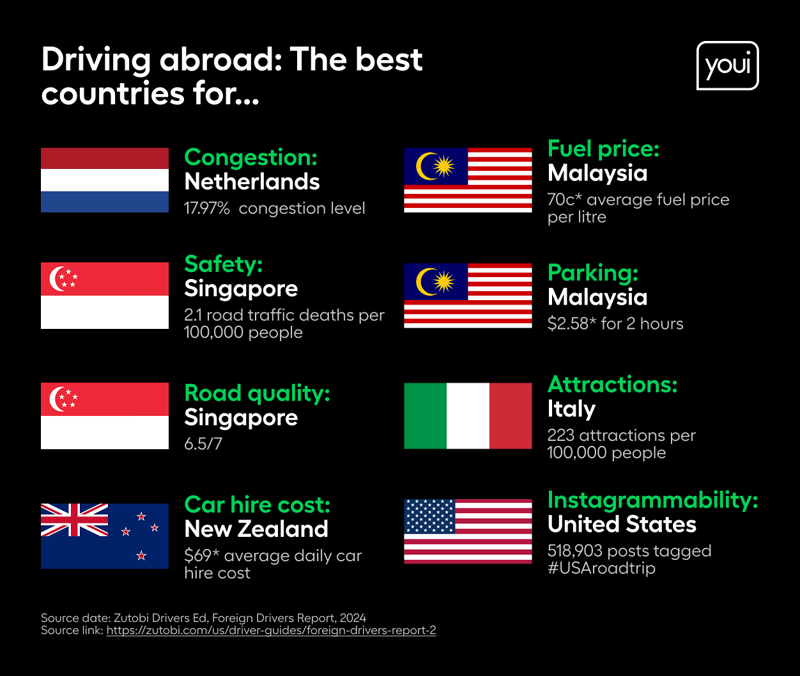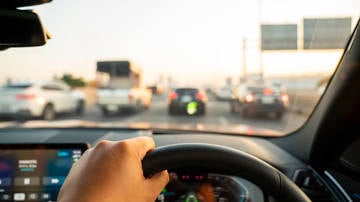If you ever leave the window of your car cracked open on a hot summer’s day while you pop to the shops or go to pay for fuel, you might well be breaking one of our lesser-known road rules – and, depending where you are, you could be fined thousands.
Yes, that’s right, that great Aussie tradition of leaving the car windows open while you tip-toe over scalding hot concrete to grab an ice cream at the corner shop directly contravenes the Australian Road Rules.1
According to Regulation 213 (5) of the Australian Road Rules, a driver must secure the windows and lock the doors of their car whenever they are more than three metres from their vehicle.1 If they fail to do so and are unlucky enough to be caught on the wrong side of this lesser-known law, the resulting fine could be a doozy.
In New South Wales and Queensland, motorists can be hit with a maximum of 20 penalty units for failing to secure their car2,3 – which means it could be up to $2,200 in NSW,4 and up to an eye-watering $3,226 in Queensland.5
For the same offence, Victorian motorists could face three penalty points,6 which is a maximum fine of around $593.7 Meanwhile, in Western Australia, motorists could be slapped with one penalty point,8 which is currently $50.9 In Tasmania, motorists will be fined up to two penalty units,10 which is $404.11.11
While it might sound like an outrageous rule to many, according to a leading driving safety expert, the reason this rule exists is to help protect not only our property, but also ourselves.
“From a safety perspective, this rule is all about preventing theft,” says Dr Darren Wishart from Griffith University.
“There are so many instances in the news every week about underage or unlicenced people driving dangerously and, generally, you’ll find if someone is going to steal a car, they’re probably less likely to be driving that car in a safe manner.”
However, not all states and territories are alike in their road rules. According to the National Transport Commission, the Australian Road Rules are model laws that merely form the basis of road rules in each Australian state and territory.12
There’s no shortage of other surprising road rules – both here and overseas – to leave you open-mouthed and frantically Googling the laws where you live.
Here are seven of the most unusual we’ve found.
1. Lights on in Switzerland
If you ever find yourself driving around the Swiss Alps (we can dream!), make sure your headlights are switched on even if it’s the middle of the day.
The European country’s Federal Road Traffic Act states it is compulsory to drive with lights on during the day. This means low-beam headlights are always required, even in the middle of the brightest day, including for mopeds and motorcycles.13
However the law also states that headlights must be used in “such a way as not to dazzle anyone unnecessarily”13 – a rule that also exists here in Australia.1
Rule 219 of the Australian Road Rules states “a driver must not use, or allow to be used, any light fitted to or in the driver’s vehicle to dazzle, or in a way that is likely to dazzle, another road user”.1 Maximum fines for breaking this rule range from up to $100 in WA8 (two penalty points)9 to a maximum of 20 penalty units totalling $3,200 in the Australian Capital Territory (ACT).14
2. Check your fuel gauge in Germany
If you’re planning a road trip along Germany’s world-famous Autobahn, make sure you have a full tank of fuel before you set off – or else you’re at risk of breaking local road rules.
Stopping on the Autobahn is illegal - except in emergencies -15 even if you’ve run out of petrol, as this is seen as a preventable circumstance.16 Other Autobahn prohibitions include U-turns, parking and backing up, while passing on the right is a strict no-no.16
3. Don’t speed up if you’re being overtaken in Australia
Back home in Australia, did you know you could be fined for speeding up when you’re being overtaken – even if you’re driving under the speed limit?1
According to Regulation 145 of the Australian Road Rules “the other driver must not increase the speed at which the driver is driving until the first driver: has passed the other driver, has returned to the marked lane or line of traffic where the other driver is driving, and is a sufficient distance in front of the other driver to avoid a collision.”1
Wishart says this is another rule that comes down to ensuring the safety of all road users – even if they’re travelling under the speed limit.
“If you’re following me in your car on a road with dotted lines and you make the assessment that it’s safe to overtake and you have the opportunity to do so, you’re making that assessment based on the speeds we’re both travelling at that moment,” he explains.
“If I speed up once you’re overtaking me, the time or gap you thought you had to overtake safely has suddenly changed, meaning you probably have to speed up which in turn, decreases your stopping distance should you need to slow down to come to a stop.”
Maximum fines for breaking this road rule range from up to $200 in WA8 to a maximum of $3,200 in the ACT.14
4. Stay inside the car or face up to a $3,200 fine
Although air conditioning is standard in most modern cars these days, there’s nothing quite like the feeling of fresh air through the windows while cruising the open road.
However, Australian drivers need to remember to keep all parts of their body (yes, including your elbow) inside the car at all times or face a fine – in the ACT it’s up to $3,200.14
Rule 268 of the Australian Road Rules states: “A person must not travel in or on a motor vehicle with any part of the person’s body outside a window or door of the vehicle, unless the person is the driver of the vehicle and is giving a hand signal.”1
“There are two main reasons for this rule,” explains Wishart. “The first is that a driver needs to be in complete control of the vehicle at all times and the second is that if two cars have a minor bump or scrape, there could be some serious consequences.”
The exception to this rule is when a driver is giving a hand signal, either for changing direction to the right, or stopping or slowing.1
5. Number plates ending with 1 or 2 are banned in Manila on Mondays
If you’ve ever been to Manila in the Philippines, you’ll know how busy it can be – especially on the roads. But instead of a congestion charge similar to the one in London,17 the Metropolitan Manila Development Authority has introduced an interesting way to help control how many cars are using the city’s roads during the week.18
The Unified Vehicular Volume Reduction Program (UVVRP) runs between 7am and 7pm every weekday in Metro Manila and bans certain cars from the roads on certain days – based on their number plate.18 Number plates ending with:
- 1 or 2 are banned on Monday
- 3 or 4 are banned on Tuesday
- 5 or 6 are banned on Wednesday
- 7 or 8 are banned on Thursday
- 9 or 0 are banned on Friday.18

Source: Zutobi Drivers Ed, Foreign Drivers Report, 2022.
6. Heading to Serbia? Pack some rope!
If you’re heading to Serbia, you might want to visit a hardware store before hiring a car.
In the eastern European country, drivers are obliged to carry a first-aid kit, warning triangle, tow rope, functional spare tyre and a reflective waistcoat.19
7. Give way to the ostrich in South Africa
We all know that the African continent is home to some of the most majestic animals in the world, but did you know that some of them have the right of way on South African roads?
In the province of KwaZulu-Natal, the fine for not giving way upon the request of a person leading or driving a bovine animal, horse, ass, mule, sheep, goat, pig or ostrich can be around A$64 (R750).20
So, what have we learned? Aside from the need to heed the ostrich in South Africa, and to pack rope before heading to Serbia, breaking the road rules in Australia can have some steep consequences.
Before you hit the road – or the corner store for that ice cream – it might be a good idea to familiarise yourself with the lesser-known road rules in your state or territory. And, of course, consider looking into car insurance. See if one of the options available at Youi could be right for you.
1 Source: Australian Parliamentary Counsel’s Committee – Australian Road Rules, June 2023
2 Source: NSW Government – Road Rules 2014
3 Source: Qld Government – Transport Operations (Road Use Management – Road Rules) Regulation 2009
4 Source: NSW Government – Increase in the value of penalty units
5 Source: Qld Government – Sentencing fines and penalties for offences
6 Source: Vic Government – Road Safety Road Rules 2017
7 Source: Vic Government – Penalties and values
8 Source: WA Government – Road Traffic Code 2000
9 Source: WA Government – Driving offences (speeding, alcohol and traffic)
10 Source: Tas Government – Road Rules 2019
11 Source: Tas Government – Penalty units indexed amounts
12 Source: National Transport Commission – Australian Road Rules
13 Source: Swiss Government – Federal Road Traffic Act
14 Source: ACT Government – Road Transport (Road Rules) Regulation 2017
15 Source: German Autobahn – Autobahn Traffic Regulations
16 Source: Auto Europe – Driving on the Autobahn in Germany
17 Source: Transport for London – Pay to drive in London
18 Source: Republic of the Philippines – Memorandum Circular No. 03
19 Source: Government of Canada – Serbia travel advice
20 Source: KwaZulu-Natal Transport – Administrative Adjudication Of Road Traffic Offences





